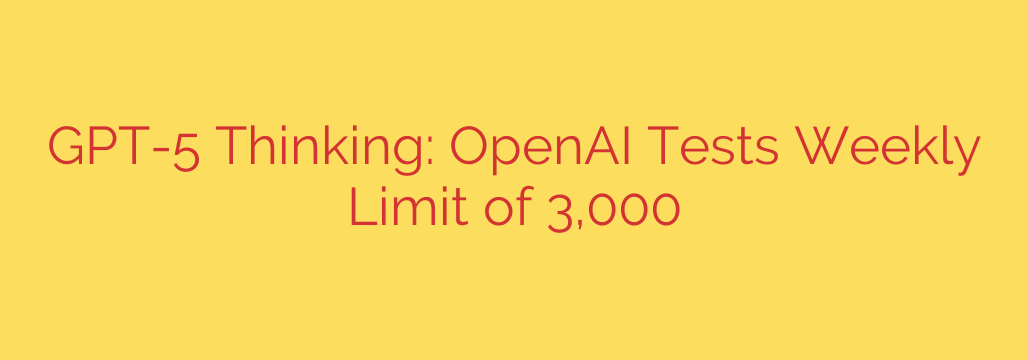
The Next Leap in AI: Is OpenAI Quietly Testing GPT-5?
The world of artificial intelligence is buzzing with speculation as signs point to OpenAI actively testing its next-generation large language model. While the company has remained tight-lipped, recent developments suggest that a powerful new model, potentially dubbed “GPT-5 Thinking,” is already in the hands of a select group of testers.
This isn’t just another incremental update. The details emerging from these early tests hint at a significant evolution in AI capabilities, moving beyond simple text generation into the realm of more complex reasoning and problem-solving.
What We Know About the “GPT-5 Thinking” Tests
The most concrete piece of information is the structure of the test itself. According to reports, a small, private group of enterprise users and trusted testers have been granted access to this new model. The most revealing detail, however, is the usage constraint placed upon them.
Testers are reportedly operating under a strict weekly limit of 3,000 interactions. This cap is significant for several reasons. It suggests that the model is either computationally expensive to run or that OpenAI is seeking highly focused, quality feedback rather than broad, casual usage. This controlled environment allows developers to closely monitor performance, identify potential issues, and gather detailed data on the model’s advanced functions.
“Thinking”: More Than Just a Name
The rumored name, “GPT-5 Thinking,” is particularly intriguing. It implies a core focus on improving the model’s ability to reason, plan, and execute multi-step tasks. While current models like GPT-4 are incredibly capable, they can sometimes falter with complex logic or abstract reasoning.
A model built around the concept of “thinking” could unlock new possibilities, including:
- Enhanced Problem-Solving: Tackling complex mathematical, scientific, and logical problems with greater accuracy.
- Deeper Contextual Understanding: Grasping nuance and subtext in conversations and documents more effectively.
- Improved Autonomy: Executing complex, long-term goals with less human intervention.
If these advanced reasoning capabilities are realized, this new model could represent a major step toward more sophisticated and reliable artificial intelligence.
What the Strict Usage Limit Implies
A weekly cap of 3,000 interactions is a strong indicator of a model in its final, resource-intensive testing phase. There are a few key takeaways from this limitation:
- High Computational Cost: Advanced AI models require immense processing power. The limit may be in place to manage the high operational costs associated with running this next-gen system during its evaluation period.
- Focus on Quality Feedback: By limiting interactions, OpenAI ensures that testers use their access for meaningful and complex tasks, providing more valuable feedback than they would from simple, high-volume queries.
- Safety and Performance Monitoring: A controlled rollout allows the team to carefully monitor for unexpected behaviors, biases, or performance bottlenecks, ensuring the model is both safe and stable before any public release.
How to Prepare for the Next Generation of AI
While an official release date for GPT-5 remains unconfirmed, these tests suggest that a launch later in 2024 is becoming increasingly plausible. As these powerful tools continue to evolve, it’s wise to prepare for their integration into our personal and professional lives.
- Stay Informed: Keep up with official announcements from major AI labs and reputable tech news sources to understand the latest capabilities and best practices.
- Master the Fundamentals: The principles of effective prompt engineering and AI interaction will only become more important. Honing these skills now will give you a significant advantage when more powerful models become available.
- Consider Ethical Implications: With greater power comes greater responsibility. Start thinking about how advanced AI can be used ethically and effectively in your field to augment human intelligence, not just replace it.
The development of “GPT-5 Thinking” marks an exciting moment in the rapid advancement of AI. While we await an official announcement, the current testing phase provides a fascinating glimpse into a future where artificial intelligence is not just a tool for information retrieval, but a powerful partner in complex thought and innovation.
Source: https://www.bleepingcomputer.com/news/artificial-intelligence/openai-is-testing-3-000-per-week-limit-for-gpt-5-thinking/








